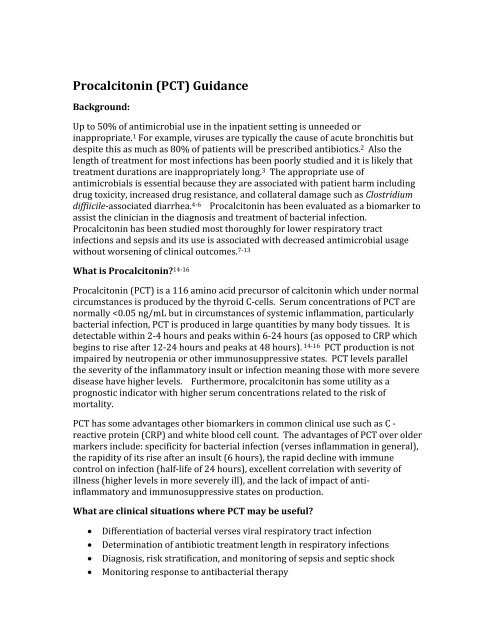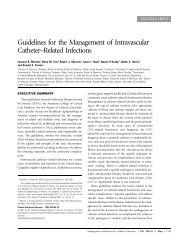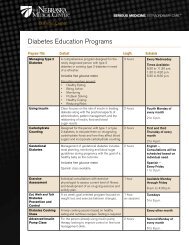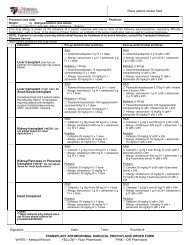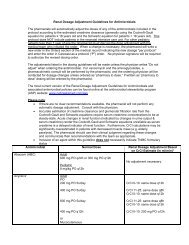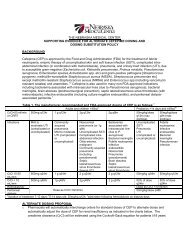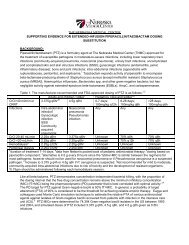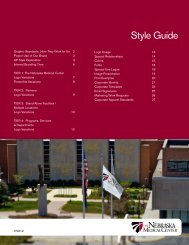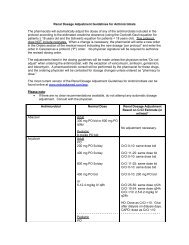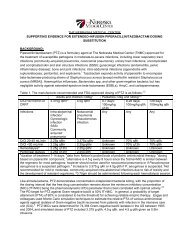Procalcitonin (PCT) Guidance - The Nebraska Medical Center
Procalcitonin (PCT) Guidance - The Nebraska Medical Center
Procalcitonin (PCT) Guidance - The Nebraska Medical Center
Create successful ePaper yourself
Turn your PDF publications into a flip-book with our unique Google optimized e-Paper software.
<strong>Procalcitonin</strong> (<strong>PCT</strong>) <strong>Guidance</strong>Background:Up to 50% of antimicrobial use in the inpatient setting is unneeded orinappropriate. 1 For example, viruses are typically the cause of acute bronchitis butdespite this as much as 80% of patients will be prescribed antibiotics. 2 Also thelength of treatment for most infections has been poorly studied and it is likely thattreatment durations are inappropriately long. 3 <strong>The</strong> appropriate use ofantimicrobials is essential because they are associated with patient harm includingdrug toxicity, increased drug resistance, and collateral damage such as Clostridiumdiffiicile-associated diarrhea. 4-6 <strong>Procalcitonin</strong> has been evaluated as a biomarker toassist the clinician in the diagnosis and treatment of bacterial infection.<strong>Procalcitonin</strong> has been studied most thoroughly for lower respiratory tractinfections and sepsis and its use is associated with decreased antimicrobial usagewithout worsening of clinical outcomes. 7-13What is <strong>Procalcitonin</strong>? 14-16<strong>Procalcitonin</strong> (<strong>PCT</strong>) is a 116 amino acid precursor of calcitonin which under normalcircumstances is produced by the thyroid C-cells. Serum concentrations of <strong>PCT</strong> arenormally
• Diagnosis of systemic secondary infection post-surgery, post-organtransplant, and in severe burns, multiorgan failure, and severe trauma• Diagnosis of bacteremia and sepsis in adults and children (includingneonates)• Differentiating bacterial verses viral meningitis• Diagnosis of renal involvement in pediatric urinary tract infections• Diagnosis of bacterial infection in neutropenic patients• Diagnosis of septic arthritisWhat is the proposed role for procalcitonin at <strong>The</strong> <strong>Nebraska</strong> <strong>Medical</strong> <strong>Center</strong>?<strong>Procalcitonin</strong> can be used at <strong>The</strong> <strong>Nebraska</strong> <strong>Medical</strong> <strong>Center</strong> to assist clinicians in thediagnosis of infection and to support antimicrobial therapy decisions. Decisionsregarding antimicrobial therapy should NOT be based solely on procalcitoninserum concentrations; procalcitonin should be placed into the clinical context ofeach patient scenario considering the site of possible infection, the likelihood ofbacterial infection, the severity of illness, and any other pertinent clinical data. Itshould be noted that <strong>PCT</strong> levels may not rise with localized infections (osteomyelitis,localized abscess, etc) and a negative <strong>PCT</strong> should not be considered to rule out alocalized infection.Lower respiratory tract infection (pneumonia, COPD exacerbation, bronchitis)Excellent evidence supports the use of <strong>PCT</strong> for assisting clinicians in antibioticmanagement in LRTI including pneumonia, exacerbations of chronic bronchitis, andother assorted lower respiratory tract infections (bronchitis, asthma exacerbation,etc.). A meta-analysis of 8 studies with 3431 patients found the use of <strong>PCT</strong> in LRTIresulted in a 31% decrease in antibiotic prescriptions and a decrease in antibioticduration of 1.3 days. 17Recommended Use: Based upon this evidence it is suggested that patientsconsidered at risk for bacterial LRTI or being started on antibiotics have a <strong>PCT</strong> valuemeasure on admission and every 2-3 days subsequently. Interpretation of values islisted below in Algorithms 1 and 2.
Algorithm 1: LRTI Initial <strong>PCT</strong> ValueAlgorithm 2: LRTI <strong>PCT</strong> Value Follow UpSepsis (SIRS, sepsis, severe sepsis, septic shock)A number of randomized trials have been performed evaluating the utility of <strong>PCT</strong>levels in guiding antibiotic therapy. <strong>The</strong>se have been summarized in 3 separatesystematic reviews/meta-analyses showing a decrease in antimicrobial exposure of19-38% without increases in mortality, length of stay, or relapsed/persistentinfection. 18-20 Most studies in sepsis have evaluated using <strong>PCT</strong> to discontinueantibiotics although one large trial did use <strong>PCT</strong> levels to assist in the decision toinitiate treatment. 7 Because of limited data, the decision to initiate therapy in theICU should be driven by the severity of illness and clinical assessment of thelikelihood of infection with the <strong>PCT</strong> used as an adjunct to assist in the decision toinitiate antibiotics. Much more rigorous evidence exists to support the use of <strong>PCT</strong> todiscontinue antibiotics.<strong>PCT</strong> levels that are not declining or are increasing are strong negative prognosticindicators of lack of control of the infection by the host immune system and/orantibiotics. It has generally been recommended that further diagnosticprocedures/imaging or broader spectrum antibiotics be initiated based upon a
ising value. A recently published large trial puts this practice in question. This trialused <strong>PCT</strong> values of >1 μg/L as an “alert” to suggest broadening of therapy andfurther imaging. 21 It did not find a mortality benefit and was associated withincreased length of stay in the ICU and on the ventilator. It is unclear whatprocesses should be initiated based upon a rising <strong>PCT</strong>, but the routine expansion oftherapy is not recommended. We recommend a careful reassessment of the patientfor other sites/sources or infection or evidence of resistant pathogens and decisionsregarding further interventions be made based upon this evaluation.Recommended Use: Based upon the above information it is recommended thatpatients admitted to the ICU with presumed sepsis/septic shock/etc have <strong>PCT</strong>drawn on admission and that <strong>PCT</strong> be repeated on the next 2 days. Decisionsregarding antibiotic therapy can then be made based upon <strong>PCT</strong> dynamics, culturedata, and patient specific clinical data. Further <strong>PCT</strong> values may be drawn at thediscretion of the physician.Algorithm 3: Sepsis Initial <strong>PCT</strong> ValueAlgorithm 4: Sepsis <strong>PCT</strong> Follow Up
How will procalcitonin be ordered and reported:<strong>Procalcitonin</strong> will be available 24 hours a day and will be run as needed. Stat orderresults will be available within 90 minutes while results of routine testing will beavailable during the same shift (usually 2-4 hours). A value of ≥ 0.1 µg/L will beflagged as elevated. Interpretation should be based upon the clinical context andalgorithms available on the Antimicrobial Stewardship Website(www.nebraskamed.com/asp). <strong>The</strong> specific comment included on the laboratoryreport is included below:Normal: 72 hours – adults)Suspected Lower Respiratory Tract Infection:0.1 – 0.25 ng/mL - Low likelihood for bacterial infection; Antibiotics discouraged.>0.25 ng/mL - Increased likelihood bacterial infection; Antibiotics encouraged.Suspected Sepsis: Strongly consider initiating antibiotics in all unstable patients.0.1 – 0.5 ng/mL - Low likelihood for sepsis; Antibiotics discouraged.>0.5 ng/mL – Increased likelihood sepsis; Antibiotics encouraged.>2.0 ng/mL – High risk of sepsis/septic shock; Antibiotics strongly encouraged.Decisions on antibiotic use should not be based solely on procalcitonin levels. Ifantibiotics are administered, repeat procalcitonin testing should be obtained every 2-3 daysto consider early antibiotic cessation. <strong>PCT</strong> is a dynamic biomarker and most useful whentrends are analyzed over time in accompaniment with other clinical data. Interpretationshould be based upon clinical context and algorithms available on the AntimicrobialStewardship Website (www.nebraskamed.com/asp).General <strong>PCT</strong> Interpretation:Sepsis: <strong>PCT</strong> levels of >2.0 μg/L predicts sepsis and levels of >10 μg/L indicate likelyseptic shock. Sensitivity and specificity of <strong>PCT</strong> for the diagnosis of sepsis has variedbased upon population and underlying diseases. Higher <strong>PCT</strong> levels have beenshown to be associated with a worse prognosis, but have not generally added to wellvalidated clinical scoring systems such as APACHE or SAPS.Febrile Children in the ED: In studies have found <strong>PCT</strong> values of >2.0 μg/L make aserious infection much more likely while values of
Bacterial Meningitis: Levels of 5 μg/L).Renal Involvement in Pediatric Urinary Tract Infections: <strong>PCT</strong> values of >0.5μg/L have a sensitivity of 70-90% and 80-90% specificity for renal involvement inpediatric patients with UTIs.What are the limitations of procalcitonin?False positive and false negative results can occur with any test and clinical contextshould guide interpretation of <strong>PCT</strong> results.Situations where the <strong>PCT</strong> elevations may be due to a non-bacterial cause:• Newborns (
Also patients with severe infections (bacteremic pneumonia) will generallytake longer for <strong>PCT</strong> levels to normalize.4. Be aware of conditions which may affect <strong>PCT</strong> levels. For example apatient with peritonitis who returns to the OR for a washout is expected tohave a transitory increase in <strong>PCT</strong> value post-operatively but should continueto trend down if the infection is adequately controlled.Costs:Clinicians should consider the increased cost associated with the use of additionaltests. <strong>PCT</strong> cost is approximately twice that of CRP, but provides greater clinicalvalue in the overall management of the patient, especially when used fordetermination of cessation of antibiotics. A cost benefit analysis of <strong>PCT</strong> use in theICU found cost savings or increased cost of care was dependant on how frequently<strong>PCT</strong> was utilized and the cost of the antibiotics which were discontinued. 19 Any costsavings through the use of <strong>PCT</strong> will be realized through decreased antibiotic use andpresumably decreased complications of antibiotic use (C. difficile infection, drugtoxicity, etc.)References:1. John JF, Fishman NO. Programmatic role of the infectious diseases physicianin controlling antimicrobial costs in the hospital. Clin Infect Dis.1997;24:471-85.2. Wenzel RP, Fowler AA. Acute bronchitis. N Engl J Med. 2006; 355:2125-21303. Hayashi Y, Paterson DL. Strategies for reduction in duration of antibiotic usein hospitalized patients. Clin Infect Dis. 2011;52:1232-40.4. Patel G, et al. Outcomes of carbapenem‐resistant Klebsiella pneumoniaeinfection and the impact of antimicrobial and adjunctive therapies. InfectControl Hosp Epidemiol. 2008;29:1099-1106.5. Shehab N, et al. Emergency department visits for antibiotic-associatedadverse events. Clin Infect Dis. 2008;47:735-43.6. Wistrom J, et al. Frequency of antibiotic-associated diarrhoea in 2462antibiotic-treated hospitalized patients: a prospective study. J Antimicrob.Chemother. 2001;47: 43-50.7. Bouadma L, et al. Use of procalcitonin to reduce patients’ exposure toantibiotics in intensive care units (PRORATA trial): a multicenter randomizedcontrolled trial. Lancet. 2010;375:463-74.8. Nobre V, et al. Use of procalcitonin to shorten antibiotic treatment durationin septic patients. Am J Respir Crit Care Med. 2008;177:498-505.
9. Stolz D, et al. <strong>Procalcitonin</strong> for reduced antibiotic exposure in ventilatorassociatedpneumonia: a randomized study. Eur Respir J. 2009;34:1364-75.10. Schuetz P, et al. Effect of procalcitonin-based guidelines vs standardguidelines on antibiotic use in lower respiratory tract infections. JAMA.2009;302:1059-66.11. Crist-Crain M, et al. Effect of procalcitonin-guided treatment on antibioticuse and outcome in lower respiratory tract infections: cluster-randomized,single-blinded intervention trial. Lancet. 2004;363:600-7.12. Stolz D, et al. Antibiotic treatment of exacerbations of COPD: a randomized,controlled trial comparing procalcitonin-guidance with standard therapy.Chest. 2007;131:9-19.13. Christ-Crain M, et al. <strong>Procalcitonin</strong> guidance of antibiotic therapy incommunity-acquired pneumonia. Am J Respir Crit Care Med. 2006;174:84-93.14. Christ-Crain and Muller. Biomarkers in respiratory tract infections:diagnostic guides to antibiotic prescription, prognostic markers an mediators.Eur Respir J. 2007;30:556-73.15. Kibe S, et al. Diagnostic and prognostic biomarkers of sepsis in critical care. JAntimicrob Chemother. 2011;66(S2):33-40.16. Schuetz P, et al. <strong>Procalcitonin</strong> for diagnosis of infection and guide toantibiotic decisions: past, present and future. BMC Medicine. 2011;9:107.17. Li H, et al. Meta-analysis and systematic review of procalcitonini-guidedtherapy in respiratory tract infections. Antimicrob Agents Chemother.2011;55:5900-6.18. Agarwal R and Schwartz DN. <strong>Procalcitonin</strong> to guide duration of antimicrobialtherapy and intensive care units: a systematic review. Clin Infect Dis.2011;53:379-87.19. Heyland DK, et al. <strong>Procalcitonin</strong> for reduced antibiotic exposure in thecritical care setting: a systematic review and an economic evaluation. CritCare Med. 2011;39:1792-9.20. Kopterides P, et al. <strong>Procalcitonin</strong>-guided algorithms of antibiotic therapy inthe intensive care unit: a systematic review and meta-analysis of randomizedcontrolled trials. Crit Care Med. 2010;38:2229-41.21. Jensen JU, et al. <strong>Procalcitonin</strong>-guided interventions against infections toincrease early appropriate antibiotics and improve survival in the intensivecare unit. Crit Care Med. 2011;39:2048-58.


